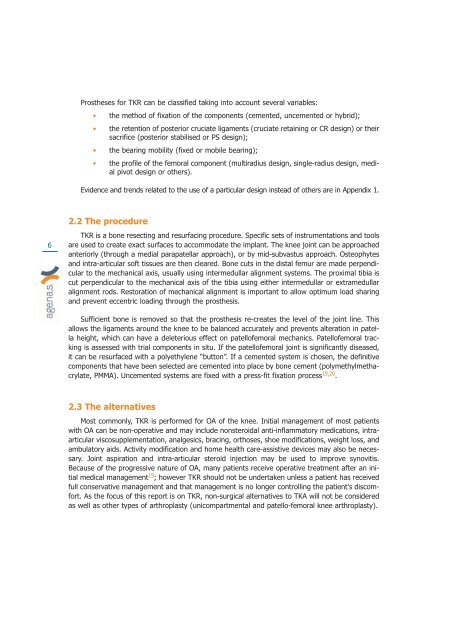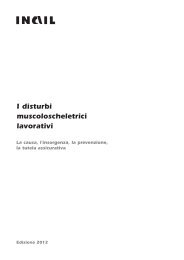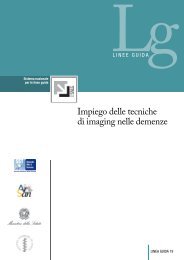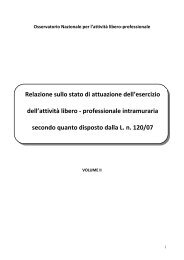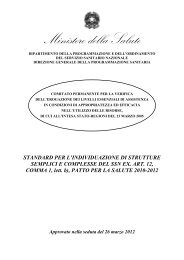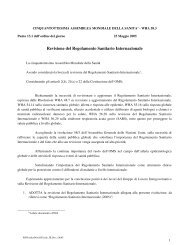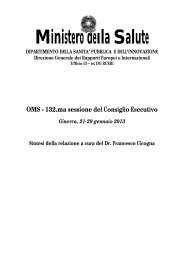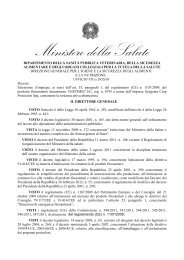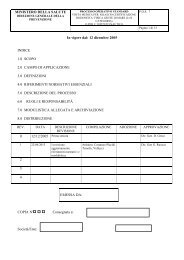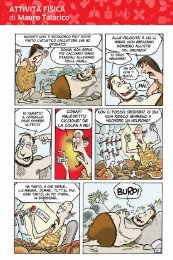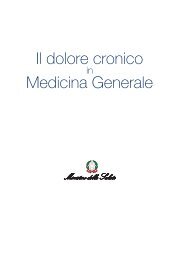hta_ knee intro.qxp - Ministero della Salute
hta_ knee intro.qxp - Ministero della Salute
hta_ knee intro.qxp - Ministero della Salute
Create successful ePaper yourself
Turn your PDF publications into a flip-book with our unique Google optimized e-Paper software.
6<br />
Prostheses for TKR can be classified taking into account several variables:<br />
• the method of fixation of the components (cemented, uncemented or hybrid);<br />
• the retention of posterior cruciate ligaments (cruciate retaining or CR design) or their<br />
sacrifice (posterior stabilised or PS design);<br />
• the bearing mobility (fixed or mobile bearing);<br />
• the profile of the femoral component (multiradius design, single-radius design, medial<br />
pivot design or others).<br />
Evidence and trends related to the use of a particular design instead of others are in Appendix 1.<br />
2.2 The procedure<br />
TKR is a bone resecting and resurfacing procedure. Specific sets of instrumentations and tools<br />
are used to create exact surfaces to accommodate the implant. The <strong>knee</strong> joint can be approached<br />
anteriorly (through a medial parapatellar approach), or by mid-subvastus approach. Osteophytes<br />
and intra-articular soft tissues are then cleared. Bone cuts in the distal femur are made perpendicular<br />
to the mechanical axis, usually using intermedullar alignment systems. The proximal tibia is<br />
cut perpendicular to the mechanical axis of the tibia using either intermedullar or extramedullar<br />
alignment rods. Restoration of mechanical alignment is important to allow optimum load sharing<br />
and prevent eccentric loading through the prosthesis.<br />
Sufficient bone is removed so that the prosthesis re-creates the level of the joint line. This<br />
allows the ligaments around the <strong>knee</strong> to be balanced accurately and prevents alteration in patella<br />
height, which can have a deleterious effect on patellofemoral mechanics. Patellofemoral tracking<br />
is assessed with trial components in situ. If the patellofemoral joint is significantly diseased,<br />
it can be resurfaced with a polyethylene “button”. If a cemented system is chosen, the definitive<br />
components that have been selected are cemented into place by bone cement (polymethylmethacrylate,<br />
PMMA). Uncemented systems are fixed with a press-fit fixation process 19,20 .<br />
2.3 The alternatives<br />
Most commonly, TKR is performed for OA of the <strong>knee</strong>. Initial management of most patients<br />
with OA can be non-operative and may include nonsteroidal anti-inflammatory medications, intraarticular<br />
viscosupplementation, analgesics, bracing, orthoses, shoe modifications, weight loss, and<br />
ambulatory aids. Activity modification and home health care-assistive devices may also be necessary.<br />
Joint aspiration and intra-articular steroid injection may be used to improve synovitis.<br />
Because of the progressive nature of OA, many patients receive operative treatment after an initial<br />
medical management 19 ; however TKR should not be undertaken unless a patient has received<br />
full conservative management and that management is no longer controlling the patient's discomfort.<br />
As the focus of this report is on TKR, non-surgical alternatives to TKA will not be considered<br />
as well as other types of arthroplasty (unicompartmental and patello-femoral <strong>knee</strong> arthroplasty).


